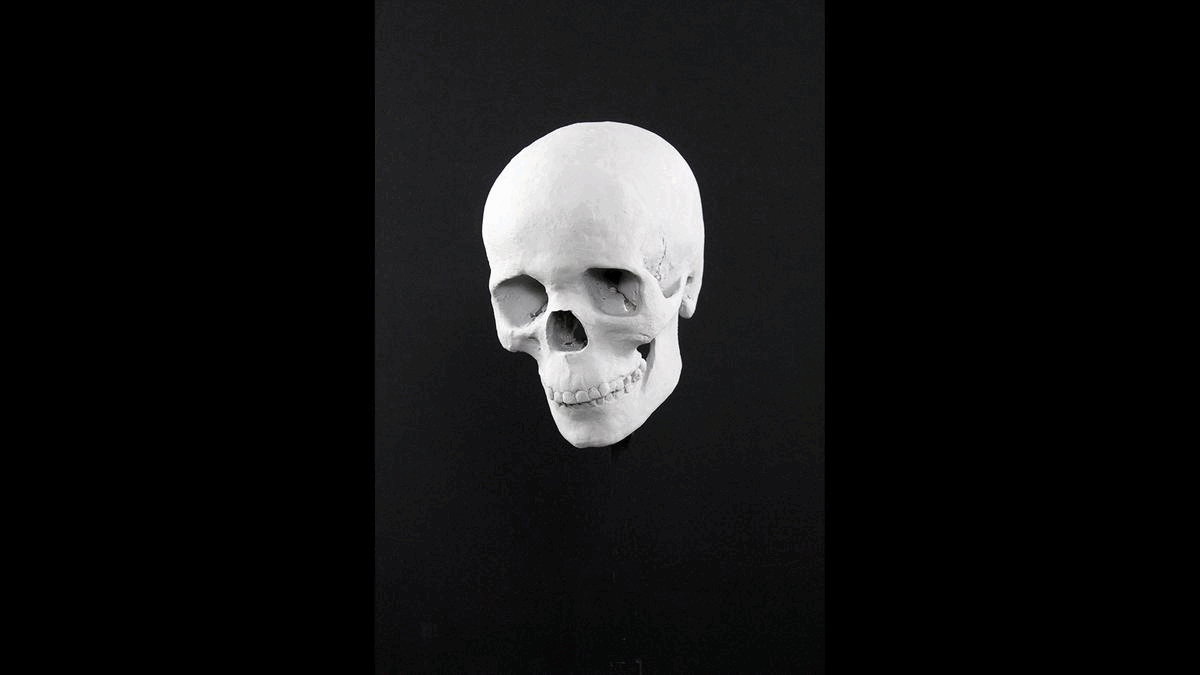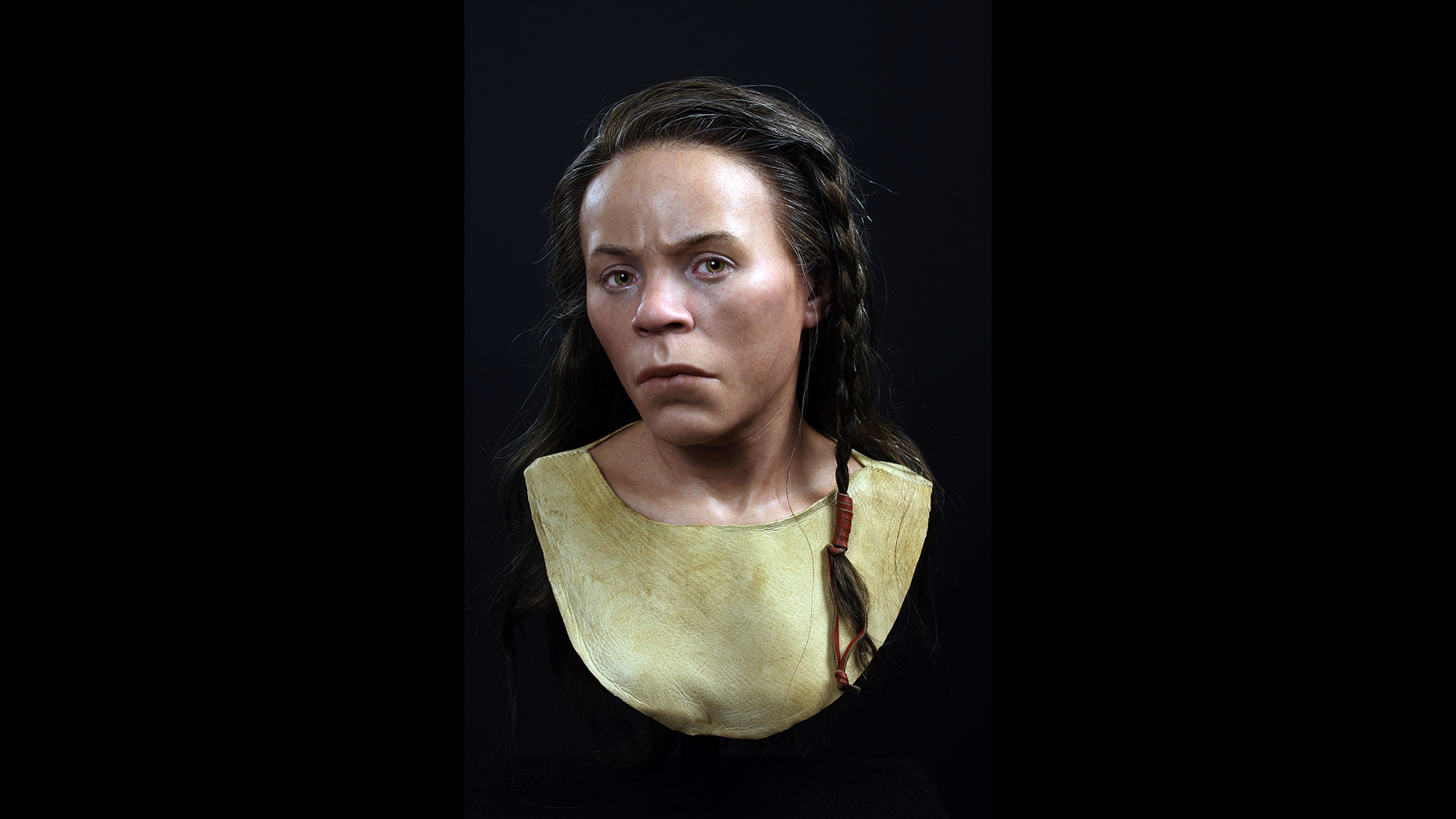See the 'amazing' facial reconstruction of a Bronze Age woman discovered crouching in a 4,200-year-old grave
The skeletal remains of the 'Upper Largie Woman' were found in a quarry in Scotland. Now, scientists have reconstructed the Bronze Age woman's face.

More than 4,000 years ago, a young woman who died in what is now Scotland was buried in a crouched position within a stone-lined grave. She remained buried for millennia, until excavators at a stone quarry unexpectedly unearthed her bones in 1997.
Little is known about the woman — dubbed Upper Largie Woman after the Upper Largie Quarry — but now, a new bust-like reconstruction reveals how she may have looked during the Early Bronze Age.
The reconstruction, which went on display Sept. 3 at the Kilmartin Museum in Scotland, shows a young woman with dark braided hair who is wearing a deer-skin outfit. And she appears to be looking at someone nearby.
"Making a reconstruction I usually think that we are looking into their world, [meaning] they don't see us," Oscar Nilsson, a forensic artist based in Sweden who crafted the woman's likeness, told Live Science in an email. "I thought it could be an interesting idea to twist this a bit, and actually thinking that she can see us. And as you can see, she looks a bit critical to us (I don't blame her for that...)!"
Related: 35 amazing facial reconstructions, from Stone Age shamans to King Tut

After the discovery of Upper Largie Woman, a skeletal and dental analysis revealed that she likely died in her 20s and experienced periods of illness or malnutrition. Radiocarbon dating found that she lived between 1500 B.C. and 2200 B.C., during the Early Bronze Age, according to the museum. Meanwhile, a look at different isotopes, or versions of strontium and oxygen from her remains suggested that she grew up locally in Scotland, but the team wasn't able to extract her DNA, so her ethnic heritage, including her skin, eye and hair color, is unknown.
However, archaeologists found sherds of Beaker pottery in her grave, hinting that she was part of the Beaker culture, named for its peoples' bell-shaped beakers. Research suggests that the Beaker culture started in Central Europe with people whose ancestors came from the Eurasian Steppe. Eventually, the Beaker culture reached Britain in about 2400 B.C. DNA evidence indicates that the Beaker culture replaced most of Britain's inhabitants, including the Neolithic communities that had built monuments such as Stonehenge.
Sign up for the Live Science daily newsletter now
Get the world’s most fascinating discoveries delivered straight to your inbox.
"The carbon dating suggests she might be a descendant of the first Beaker newcomers," Sharon Webb, director and curator of Kilmartin Museum, told Live Science in an email.
For the reconstruction of Upper Largie Woman, her skull was CT (computed tomography) scanned and then 3D printed in Scotland. However, "she lacked her mandible [lower jaw], and her left side of the cranium was in a quite fragmented condition," Nilsson said. "So, the first thing I had to do was to rebuild the left side of her cranium. And then to create a mandible, a rather speculative issue of course."
Then, Nilsson took her age, sex, weight and ethnicity into account, as these factors help determine tissue thickness. "So, in this case: a woman, about 20-30 years of age, signs of undernourishment in a period of her life, and a probable origin from the region," he said.
Nilsson pulled from a chart of modern individuals who fit these characteristics, then used their tissue measurements to begin sculpting the reconstruction. Pegs placed on the replica skull helped him measure the tissue depth, which he then covered with plasticine clay as he molded the facial muscles. Based on her skull's contours, he noted that Upper Largie Woman's eyes were wide set and that her nose was broad and "probably a bit turned upwards." She also had a rounded forehead and a broad mouth.
"I found it interesting that once she was reconstructed, I did not see that much of her malnutrition," Nilsson said. "She had a very rounded facial skeleton, which helped her looking a bit more healthy than she may have been."
However, he was clear that "the colors were all qualified guesses, based on other burials from the time and the region, where the DNA was in better shape than this one."
Webb called the reconstruction "absolutely amazing, we wanted her expression to be asking questions of the visitor, wondering who they are, and what their lives were like so that visitors might also ponder her life."
Upper Largie Woman's remains are now "sensitively 'reburied'" in the same position and orientation she was likely buried in 4,000 years ago, Webb said. Visitors can see her reconstruction at the museum's permanent exhibit.

Laura is the archaeology and Life's Little Mysteries editor at Live Science. She also reports on general science, including paleontology. Her work has appeared in The New York Times, Scholastic, Popular Science and Spectrum, a site on autism research. She has won multiple awards from the Society of Professional Journalists and the Washington Newspaper Publishers Association for her reporting at a weekly newspaper near Seattle. Laura holds a bachelor's degree in English literature and psychology from Washington University in St. Louis and a master's degree in science writing from NYU.










